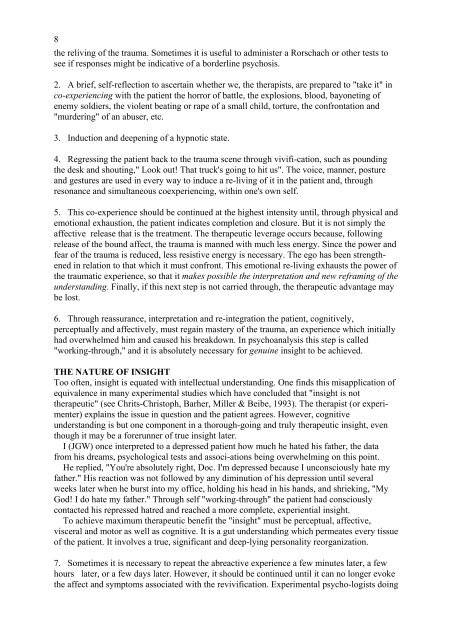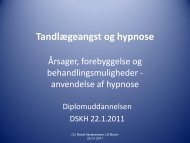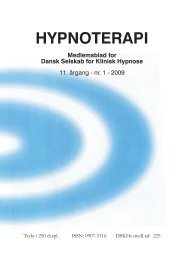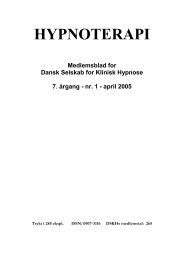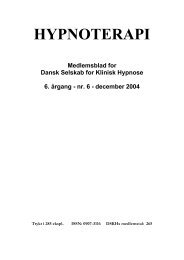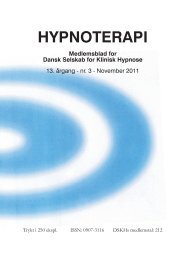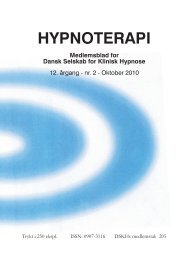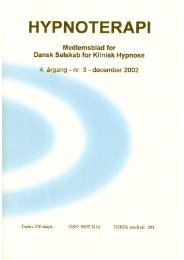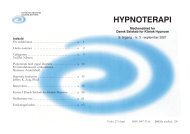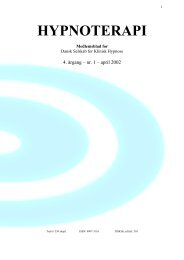HYPNOTERAPl - Dansk Selskab for Klinisk Hypnose
HYPNOTERAPl - Dansk Selskab for Klinisk Hypnose
HYPNOTERAPl - Dansk Selskab for Klinisk Hypnose
Create successful ePaper yourself
Turn your PDF publications into a flip-book with our unique Google optimized e-Paper software.
8<br />
the reliving of the trauma. Sometimes it is useful to administer a Rorschach or other tests to<br />
see if responses might be indicative of a borderline psychosis.<br />
2. A brief, self-reflection to ascertain whether we, the therapists, are prepared to "take it" in<br />
co-experiencing with the patient the horror of battle, the explosions, blood, bayoneting of<br />
enemy soldiers, the violent beating or rape of a small child, torture, the confrontation and<br />
"murdering" of an abuser, etc.<br />
3. Induction and deepening of a hypnotic state.<br />
4. Regressing the patient back to the trauma scene through vivifi-cation, such as pounding<br />
the desk and shouting," Look out! That truck's going to hit us". The voice, manner, posture<br />
and gestures are used in every way to induce a re-living of it in the patient and, through<br />
resonance and simultaneous coexperiencing, within one's own self.<br />
5. This co-experience should be continued at the highest intensity until, through physical and<br />
emotional exhaustion, the patient indicates completion and closure. But it is not simply the<br />
affective release that is the treatment. The therapeutic leverage occurs because, following<br />
release of the bound affect, the trauma is manned with much less energy. Since the power and<br />
fear of the trauma is reduced, less resistive energy is necessary. The ego has been strengthened<br />
in relation to that which it must confront. This emotional re-living exhausts the power of<br />
the traumatic experience, so that it makes possible the interpretation and new reframing of the<br />
understanding. Finally, if this next step is not carried through, the therapeutic advantage may<br />
be lost.<br />
6. Through reassurance, interpretation and re-integration the patient, cognitively,<br />
perceptually and affectively, must regain mastery of the trauma, an experience which initially<br />
had overwhelmed him and caused his breakdown. In psychoanalysis this step is called<br />
"working-through," and it is absolutely necessary <strong>for</strong> genuine insight to be achieved.<br />
THE NATURE OF INSIGHT<br />
Too often, insight is equated with intellectual understanding. One finds this misapplication of<br />
equivalence in many experimental studies which have concluded that "insight is not<br />
therapeutic" (see Chrits-Christoph, Barher, Miller & Beibe, 1993). The therapist (or experimenter)<br />
explains the issue in question and the patient agrees. However, cognitive<br />
understanding is but one component in a thorough-going and truly therapeutic insight, even<br />
though it may be a <strong>for</strong>erunner of true insight later.<br />
I (JGW) once interpreted to a depressed patient how much he hated his father, the data<br />
from his dreams, psychological tests and associ-ations being overwhelming on this point.<br />
He replied, "You're absolutely right, Doc. I'm depressed because I unconsciously hate my<br />
father." His reaction was not followed by any diminution of his depression until several<br />
weeks later when he burst into my office, holding his head in his hands, and shrieking, "My<br />
God! I do hate my father." Through self "working-through" the patient had consciously<br />
contacted his repressed hatred and reached a more complete, experiential insight.<br />
To achieve maximum therapeutic benefit the "insight" must be perceptual, affective,<br />
visceral and motor as well as cognitive. It is a gut understanding which permeates every tissue<br />
of the patient. It involves a true, significant and deep-lying personality reorganization.<br />
7. Sometimes it is necessary to repeat the abreactive experience a few minutes later, a few<br />
hours later, or a few days later. However, it should be continued until it can no longer evoke<br />
the affect and symptoms associated with the revivification. Experimental psycho-logists doing


